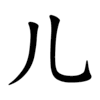儿
| ||||||||
Translingual
| Traditional | 兒 |
|---|---|
| Shinjitai | 児 |
| Simplified | 儿 |
| Stroke order | |||
|---|---|---|---|
| Stroke order | |||
|---|---|---|---|
 | |||
Han character
儿 (radical 10, 儿+0, 2 strokes, cangjie input 中山 (LU), four-corner 22010, composition ⿰丿乚)
- Kangxi radical #10, ⼉.
Related characters
- 兒 (Traditional form of 儿)
Descendants
- ㄦ (Zhuyin alphabet)
References
- KangXi: page 123, character 1
- Dai Kanwa Jiten: character 1336
- Dae Jaweon: page 257, character 21
- Hanyu Da Zidian: volume 1, page 264, character 4
- Unihan data for U+513F
Chinese
Glyph origin
| Historical forms of the character 儿 | ||||
|---|---|---|---|---|
| Shang | Western Zhou | Shuowen Jiezi (compiled in Han) | Liushutong (compiled in Ming) | |
| Bronze inscriptions | Oracle bone script | Bronze inscriptions | Small seal script | Transcribed ancient scripts |
 |
 |
 |
 |
 |
Etymology 1
Definitions
| For pronunciation and definitions of 儿 – see 兒 (“child; one's own child; son; etc.”). (This character, 儿, is the simplified form of 兒.) |
Notes:
|
Usage notes
- It may be used to specially write erhua (or the rhotic sound) in traditional Chinese, in contrast with 兒/儿 (ér, “child”).
- 1950, 林濤 (Lin Tao), 定型化新文字 (Dingshinghua Sin Wenz), 2nd edition, 生活·讀書·新知三聯書店:
- 有人把拉丁化新文字的方案跟寫法看做神聖不可侵犯的東西,不准有一點儿改變 […]
- There are some who believe that the Latinxua Sin Wenz scheme and spelling are sacred things that should not be violated, and that there must not be even the tiniest bit of change […]
- r念“儿”只有“兒”“二”“而”這幾個字 […]
- When r is read as 儿, the only candidates are "child", "two", and "and" […]
-
- When used to represent erhua, it may be subscript.
- 1968, 趙元任 (Yuen Ren Chao), 語言問題 [Problems in Linguistics], 臺灣商務印書館, page 83:
- 固然平常念一個單字的時候,重音的音節在樂音上也是高一點儿,不過它不一定老是這個樣子。
- Admittedly, when pronouncing these a word, the stressed syllable is, musically speaking, a bit higher-pitched, but this is not necessarily always the case.
-
Etymology 2
Japanese
References
|
- Source: EDICT and KANJIDIC files licensed by the Electronic Dictionaries Research Group.
Usage notes
儿 appears only as a radical in Japanese.
Korean
Vietnamese
Han character
- This term needs a translation to English. Please help out and add a translation, then remove the text
{{rfdef}}.
References
This article is issued from
Wiktionary.
The text is licensed under Creative
Commons - Attribution - Sharealike.
Additional terms may apply for the media files.